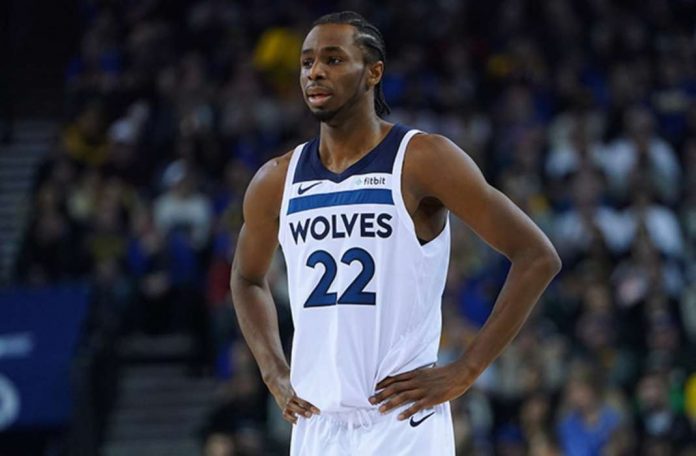On paper 17.6 points, 4.8 rebounds, and 2.4 assists per game is nothing to sniff at. Those are solid numbers for a second/third option on an NBA team.
Unfortunately for Andrew Wiggins, and the Minnesota Timberwolves,
When the Cleveland Cavaliers selected Andrew Wiggins first overall in the NBA Draft, it was a solid pick for a rebuilding franchise. Then LeBron James announced his return to “the Land,” and Wiggins was shipped to Minnesota along with Anthony Bennett and Thaddeus Young for Kevin Love (with Alexey Shved and Luc Richard Mbah a Moute headed to Philadelphia).
In a matter of weeks, Wiggins went from being the face of a franchise to filling the shoes of a franchise cornerstone. It’s a lot of pressure for a 19-year old, and initially, Wiggins responded. He earned Rookie of the Year honors, averaging 16.9 points, 4.6 rebounds, and 2.1 assists per game on .437/.310/.760 shooting splits. The 3PT shooting wasn’t exactly encouraging, but in his lone season at Kansas, Wiggins knocked down 34.1% of his attempts from beyond the arc, suggesting room for improvement.
It’s now year five, and Wiggins is a career 33.0% shooter from deep. This season, he’s shooting 32.9% on 4.7 attempts per game. His best percentage came in the 2016-17 season where he knocked down 35.6% of his 3PTs.
His percentages have only gone down since then, and that includes Jimmy Butler, one of the NBA’s premier stars, coming to town.
“The best ability is availability” is how the saying goes. However, for Wiggins, that hasn’t proven true. He’s appeared in all but one of the 391 games he could’ve played in, but that hasn’t equaled production.
Wiggins has never shot above 46% from the field. This season, he’s averaging a career-worst 40.0 FG% on 16.4 FGA per game, ranking 24th among qualified small forwards and 113th among all NBA players. Put differently, Wiggins averages the second-most shots per game on the Timberwolves and isn’t even in the top-10 on his team for FG% (he’s 13th).
FT% can be a saving statistic for players, indicating low shooting-percentages are an anomaly and that improvement will come. For Wiggins, it’s been the opposite. It’s been two seasons since Wiggins has shot above 70% at the charity stripe, including last season where he shot 64.3%. Wiggins has brought that number back up to 69.0% this season, but having a 12% decrease in FT% and then not even improving it half of the original decrease with just a few games left in the regular season isn’t a good look.
Advanced statistics aren’t a fan of Wiggins either.
Wiggins’ offensive rating this season is a 99 (league average is a 110.2), and his defensive rating is 111.4 (which certainly contributes to the Timberwolves 24th-ranked team defense).
Wiggins has contributed 0.3 win shares to the Timberwolves’ season. No, not even one. His offensive box +/- this season is -2.1, and his defensive box +/- is a -1.3. The offensive box +/- is a career worst, and his defensive box +/- is 0.7 better than his career mark of -2.0.
What about his VORP? -0.8, meaning that a “replacement level player” would be more valuable than Wiggins.
For his career, the Timberwolves have performed better with him off the court, the lone exception being the only time he was positive in +/-, last season. In other words, the Timberwolves perform better with Wiggins off the court.
One redeeming part of Wiggins’ game is his shooting at the rim. Shots 0-3 feet from the rim have comprised 26.0% of his shot attempts this season, where he’s shooting 60.6%. The next best FG% of FGA (3-10, 10-16, 16-3PT, 3PT) is from 3-10, where Wiggins is converting 34.9% of those attempts. Then it goes 33.3%, 30.6%,
For his career, Wiggins averages 0.6 blocks per game and 1.0 steals per game. This seasons he’s averaging 0.7 blocks per game and 1.0 steals per game. Those numbers actually aren’t that bad compared to other small forwards, but with a 7’0” wingspan, 44” vertical, and an 8’11” standing reach, you’d think those numbers would be a little higher.
Andrew Wiggins also puts the Timberwolves in a tough position. Jeff Teague has a $19 million player option for next season which he’ll assuredly exercise. The Timberwolves could cut Robert Covington’s $11.3 million non-guaranteed contract, but he’s the Timberwolves’ best defender, and the financial savings wouldn’t do them much good.
To make that a lot simpler, the Timberwolves are going to have roughly $90 million tied up in Jeff Teague, Gorgui Dieng, Andrew Wiggins, and Karl-Anthony Towns next season.
It’d be one thing if Wiggins was still on his rookie contract, but he’s on a rookie-max contract extension that’ll pay him at least $27.5 million through 2023, maxing out at $33.6 million in the final year. NBA teams know what Wiggins is. The Lakers would rather still have Luol Deng and Timofey Mozgov still on their team.
(Okay, maybe that was a stretch, but the Lakers are still paying the price for those contracts).
Andrew Wiggins could still turn things around, but the Timberwolves are headed to directionless franchise territory.

